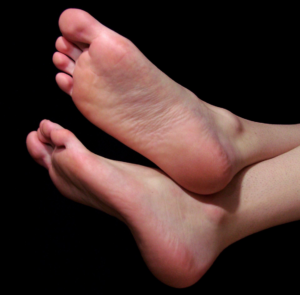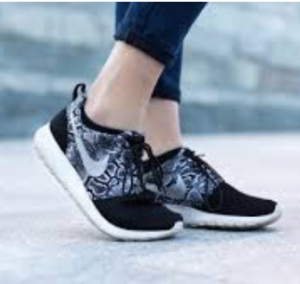WEIGHT WATCHERS Magazine — Those Fabulous Feet
PUT YOUR BEST FOOT FORWARD
 Give you feet lots of TLC and they’ll take you (literally) to the ends of the earth!
Give you feet lots of TLC and they’ll take you (literally) to the ends of the earth!
By Elaine Rogers
Go ahead, prop up your feet and take a good gander. During your lifetime, those homely little mobile machines are likely to trek 115,000 miles – a distance equal to four time the earth’s circumference. With each step, they must bear the gravity-induced pressure of up to twice your body weight. This means a 150-pound woman puts 225 to 300 pounds of pressure on her feet when she walks.
Fortunately, our feet are usually equal to the task. Though it may look delicate,
the human foot is actually a strong, complex structure comprised of 28 bones, 19 muscles, 35 joints and more than 100 ligaments – all designed to work together efficiently and effectively.
That’s not to say that feet are indestructible. Unfortunately, a combination of abuse and degeneration often load them with more than their fair share of stress. Ill-fitting, poorly designed shoes (including may high heels) may lead to foot discomfort in the short-term and serious foot problems in the long-term – especially if you are overweight.
 According to Charles J. Gudas, D.P.M., professor of orthopedic surgery at the University of Chicago Medical Center, obese individuals may have up to 70 percent more foot ailments than their trimmer counterparts. “Excess weight puts extra stress on feet, which can lead to corns, calluses, weakened arches and heel spurs,” he says.
According to Charles J. Gudas, D.P.M., professor of orthopedic surgery at the University of Chicago Medical Center, obese individuals may have up to 70 percent more foot ailments than their trimmer counterparts. “Excess weight puts extra stress on feet, which can lead to corns, calluses, weakened arches and heel spurs,” he says.
Such problems tend to increase as we get older; by age 50, our feet may have lost some of their natural arch and much of their resiliency. Moreover, the fat pad which cushions the ball of the foot atrophies as we age, causing increased pressure on the skin. Not surprisingly, 80 percent of adults over age 50 suffer from one or more painful foot conditions.
USE THEM, DON’T ABUSE THEM
Although at this point you might decide to hang up your sneakers and give your feet a well- deserved rest, don’t! Podiatrists prescribe walking as the ideal way to strengthen the feet while toning up the entire body.
William D. McArdle, Ph.D., an exercise physiologist at Queens College in New York, explains tha walking is a softer, safer activity than running or aerobic dance because it minimizes the joint-impact of more vigorous activities. And if you’re overweight, he adds, walking is especially beneficial because it is a low-impact, weight-bearing activity, and as such, actually utilizes those extra pounds to make the body work harder and bur calories faster than it would during a non weight-bearing activity, such as stationary bicycling or swimming.
In addition to burning body fat, walking helps to increase circulation, keeps joints flexible and helps fortify feet against injury. Dr. Gudas explains that walking does this by conditioning the four major sets of muscles on the bottom of the foot  and the leg muscles by gently stressing and subsequently strengthening them.
and the leg muscles by gently stressing and subsequently strengthening them.
FOCUS ON FEET
The key to foot comfort, according to James Rippe, M.D., director of the exercise physiology laboratory at the University of Massachusetts Medical School, is wearing the right shoes and taking good care of your feet. For instance, inner-sole cushions inserted into shoes provide extra shock absorption to protect against heel pain. Moleskin and other over-the-counter foot padding products help relieve the discomfort of bunions, corns and calluses. However, experts warn that if you experience foot pain, you shouldn’t ignore it or try to “walk through” it. “Foot pain is a warning signal that something is wrong,” Rippe adds. If over-the-counter remedies don’t end discomfort, he suggests a visit to a podiatrist or orthopedic surgeon.
Rippe and Dr. Scholl’s Foot Health Council stress the fact that anyone who does a lot of walking – for weight loss, fitness or simply as part of their everyday routine – should practice meticulous footcare. Their recommendations include wearing cotton or cotton and orlon socks to minimize moisture retention and allow the skin to breathe; keeping nails trimmed to avoid ingrown toenails; taking shoes off promptly after exercise to allow feet to dry completely; and using a foot powder to protect against fungal infections such as athlete’s foot.
They also suggest massaging feet often; bathing feet regularly in warm, soapy water; and applying a moisturizing lotion to the feet after bathing to keep the skin between the toes from cracking, itching or flaking. Gently rub any hardened foot skin with a pumice stone too, to avoid callus buildup. And last but not least, invest in the right walking shoes. (More on this, page 16.)
Now that you’re giving your feet plenty of TLC in the form of good grooming and proper footwear, don’t forget to give your tootsies an occasional break. The Council recommends elevation your feet above hip level for a short time each day. Your feet will thank you for it.
